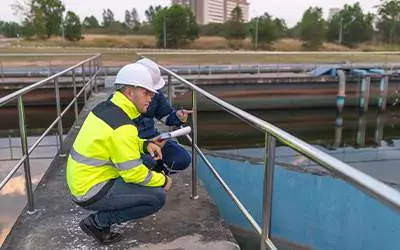ASI’s Corrosion Assessments for Steel and Concrete Structures

Why Corrosion Assessment in Steel and Concrete Are Necessary?
Corrosion isn’t just a cosmetic issue; it’s a serious threat that can weaken the very foundation of your steel and concrete structures. Over time, exposure to the elements can degrade their strength, turning what should be a sturdy, reliable structure into something far less dependable. Small issues can sneak up on you without regular checks, eventually leading to hefty repair bills or, even worse, compromising safety.
Corrosion in Steel – An Overview
Steel is renowned for its strength and durability but is not invincible. When steel is exposed to oxygen and water, a chemical reaction kicks in, resulting in rust, or iron oxide. This rust doesn’t just sit on the surface; it actively eats away at the steel, slowly but surely compromising the structure’s integrity. What might start as a tiny spot of rust can spread and deepen over time, turning a strong, reliable piece of steel into something far less dependable. This slow and silent process can cause serious issues if not identified and addressed early on.
Causes:
- Moisture: High humidity and exposure to water can accelerate the rusting process.
- Salts: De-icing salts or exposure to seawater can speed up corrosion significantly.
- Mechanical Damage: Scratches, dents, or any physical damage can expose steel to the elements, making it more susceptible to corrosion.
Effects:
- Structural Weakening: Corrosion reduces the strength and integrity of the steel, leading to potential safety hazards.
- Aesthetic Damage: Rust stains and surface deterioration can make structures look unsightly and neglected.
- Increased Maintenance Costs: Addressing corrosion issues can become expensive, especially if the damage has spread.
Corrosion in Concrete – An Overview
Concrete may seem tough and resilient, but it has its own vulnerabilities, particularly when steel is embedded within it. The real trouble begins when the embedded steel starts to react with chlorides from salts or carbonation. This reaction triggers the steel’s corrosion, leading to a domino effect within the concrete itself. As the steel corrodes, it expands, creating internal pressure that causes the surrounding concrete to crack and deteriorate. What starts as a hidden issue within the concrete can quickly become visible, manifesting in cracks, surface damage, and a significant reduction in the overall durability of the structure.
Causes:
- Chloride Ingress: Salts, especially in environments with de-icing salts or seawater, penetrate the concrete and reach the embedded steel, initiating corrosion.
- Carbonation: Over time, carbon dioxide from the air reacts with the concrete, lowering its pH and making it easier for the steel inside to corrode.
- Moisture Penetration: Cracks in the concrete allow moisture to seep in, accelerating the corrosion of the embedded steel.
Effects:
- Cracking: Corrosion of the embedded steel causes the concrete to crack as the steel expands.
- Spalling: The surface of the concrete may start to break off, leaving the structure looking damaged and weathered.
- Reduced Durability: Corrosion compromises the strength and longevity of the concrete, making it less durable over time.
- Higher Repair Costs: The damage from corrosion often leads to expensive repairs to restore the structure’s integrity.
ASI’s Corrosion Assessments
At ASI, we understand that corrosion can be a major headache for steel and concrete structures. That’s why our corrosion assessments are designed to be thorough and proactive, ensuring you catch potential issues before they become serious problems. Here’s a closer look at how we tackle corrosion to keep your assets in top shape:
Condition Assessment:
- Support Structures: We start by closely examining metal support structures, particularly those exposed to the elements or in harsh environments. These areas are often the first to show signs of corrosion damage. Our goal is to spot any visible issues early on so you can address them before they worsen.
- Hardware and Connections: Next, we turn our attention to exposed hardware, connectors, and terminals. We check for any signs of corrosion buildup or discoloration. Corrosion in these components can lead to performance issues or even failures if not addressed promptly.
- Corrosion Rate: We assess environmental conditions like humidity, moisture fluctuations, and exposure to chemicals or pollutants. These factors can significantly influence the rate of corrosion, so understanding them helps us provide a more accurate assessment.
Localized Testing:
- Electrical Conductivity: To ensure everything is running smoothly, we use tools like multimeters or continuity testers to check the electrical conductivity across connections and terminals.
- Thickness and Section Loss: We measure thickness losses, section thinning, and pitting. These tests help us understand how much material has been lost due to corrosion and identify any localized damage that might compromise the structure.
- Insulation Resistance: We perform insulation resistance tests for cables and wiring. This helps us evaluate whether the insulation is still intact and effective, which is crucial for maintaining electrical safety and performance.
Moisture and Environmental Checks:
- Moisture Sources: Identifying sources of moisture ingress is key to preventing corrosion. We look for exposure to corrosive environments like salt spray or industrial pollutants. By pinpointing these sources, we can help you take preventive measures.
- Salts: Salt air is corrosive because it’s hygroscopic – it attracts water. The salt attracts moisture from the environment to the steel substrate, which speeds up the oxidation (rusting) process. Salt is in the environment, which means the effects of salt can be found on the surface of your steel asset.
- Enclosures and Buried Areas: We inspect enclosures and areas buried underground to ensure they effectively prevent moisture penetration. If these areas are not properly sealed, moisture can seep in and start causing corrosion problems.
Corrosion Mapping:
- Documentation: We create detailed diagrams or drawings to document and map out areas with visible corrosion. This helps us track the location and severity of the damage, giving you a clear picture of where to prioritize corrosion prevention and repairs.
- Prioritization: We prioritize areas for further inspection or remedial action based on our findings. This way, we focus on the most critical areas, ensuring that you promptly address the most significant issues.
Corrosion Protection Systems:
- Cathodic Protection: Cathodic protection is one of the most effective methods for preventing corrosion on a metal surface. ASI evaluates the effectiveness and/or need for cathodic protection, which is commonly used to protect numerous structures against corrosion, including transmission towers, pipelines, tanks, and basically all submerged or buried metal structures.
- Protective Coatings: Finally, we evaluate the effectiveness of any protective coatings or corrosion-resistant materials used in your structures. Over time, these coatings can degrade, so ensuring they’re still providing adequate protection is important.
Asset Strategy Inc. – Experts in Corrosion Assessments
At ASI, our engineers and technologists are equipped with the expertise and credentials needed to tackle corrosion challenges head-on. We are proud to be certified by the Association of Materials Protection and Performance (AMPP), ensuring that our assessments are thorough and aligned with industry standards and best practices.
Understanding Asset Management: The Importance of Asset Condition and Remaining Service Life
Effective asset management is essential in business environments, particularly infrastructure and facility management.
How ASI Ensures Top-Quality Facility Condition Assessments: A Step-by- Step Overview
Facility condition assessments are essential for maintaining safety, identifying potential risks, and ensuring compliance…
ASI’s Guide to Maintaining Municipal Water, Wastewater, and Storm Water Systems
Maintaining the integrity and functionality of municipal water systems is a critical responsibility that directly impacts public health and safety. These systems…


